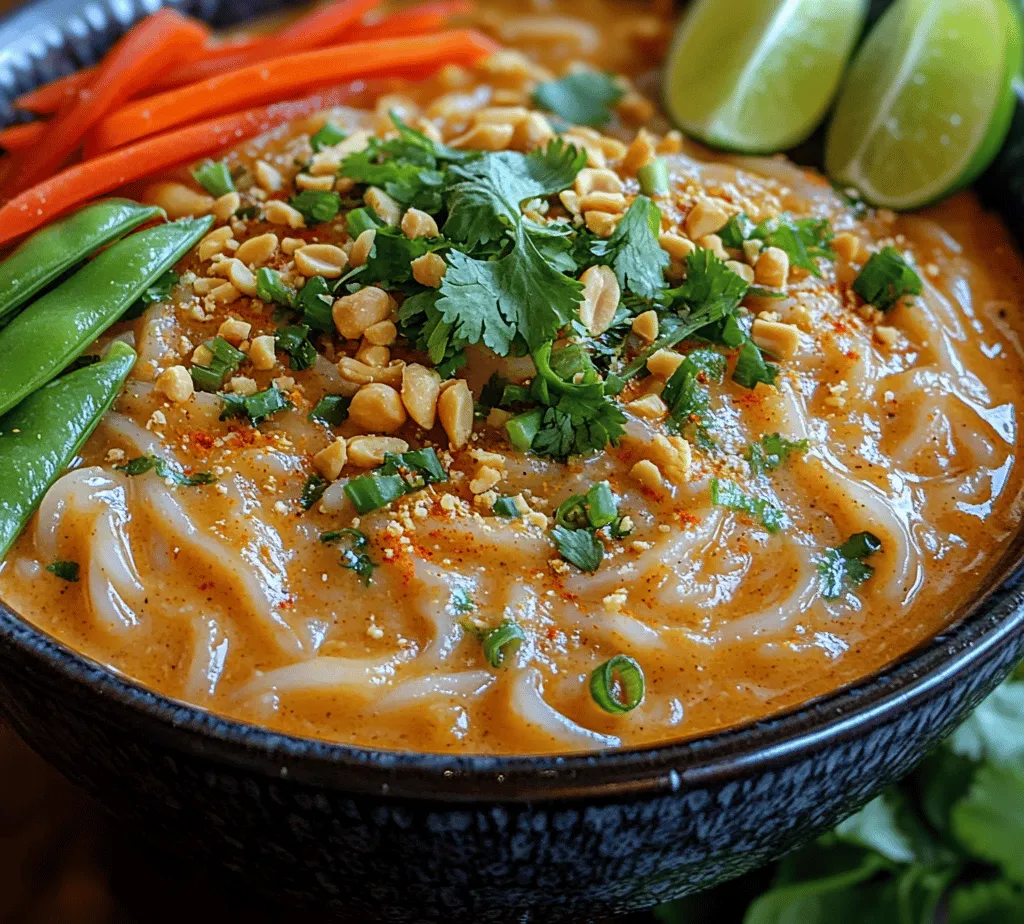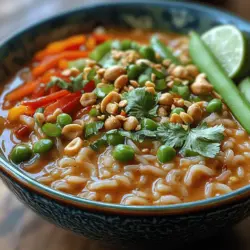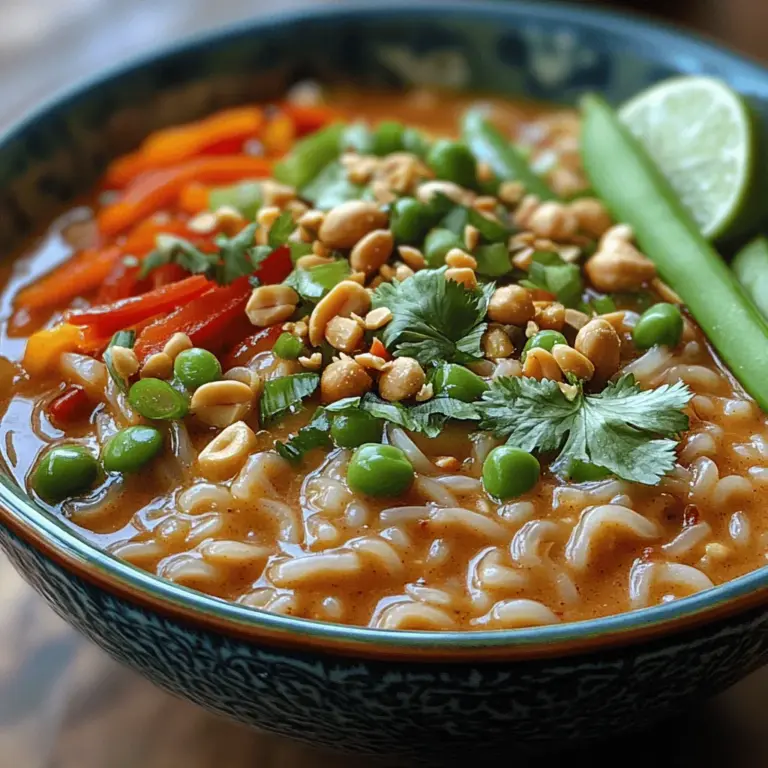Introduction
Thai cuisine has captured the hearts and taste buds of food lovers around the world with its bold flavors, vibrant colors, and aromatic spices. Whether it’s the fragrant curries, the zesty salads, or the rich noodles, there’s a dish for every palate. Among these culinary treasures, Spicy Thai Peanut Noodles stand out as a delicious and versatile option that seamlessly blends heat and creaminess in every bite. This dish is not just a meal; it’s an experience that showcases the harmony of flavors typical of Thai cooking.
Spicy Thai Peanut Noodles are characterized by their luscious peanut sauce, which coats rice noodles perfectly and is complemented by an array of fresh vegetables. The result is a delightful combination of creamy, spicy, and crunchy textures that keep you coming back for more. Whether served as a main dish or a side, this recipe can easily adapt to suit your preferences and dietary needs, making it a favorite in both home kitchens and restaurants alike.
In this article, we’ll dive deep into the key ingredients that make this dish special, explore its nutritional benefits, and provide a comprehensive step-by-step guide to preparing these enticing noodles. Get ready to tantalize your taste buds with a dish that embodies the essence of Thai cuisine!
Understanding the Ingredients
Before we begin cooking, it’s essential to understand the key ingredients that contribute to the unique flavor profile of Spicy Thai Peanut Noodles. Each element plays a crucial role in creating the dish’s signature taste and texture.
Rice Noodles
Rice noodles are the backbone of this dish, providing a light and chewy texture that perfectly complements the peanut sauce. When choosing rice noodles, opt for flat or thin varieties such as bánh phở or sen yai. These noodles are gluten-free, making them an excellent option for those with gluten sensitivities. The cooking process is straightforward: soak or boil them until they reach a tender yet firm consistency. This will prevent them from becoming mushy and ensure they maintain their delightful bite.
Peanut Butter
The star of the show is undoubtedly the peanut butter, which brings a rich, nutty flavor and creamy texture to the sauce. When selecting peanut butter for this recipe, look for natural options without added sugars or hydrogenated oils. The creaminess of the peanut butter helps create a smooth sauce that clings to the noodles beautifully. Plus, it’s a great source of healthy fats and protein, making this dish both satisfying and nutritious.
Soy Sauce and Sriracha
To achieve the perfect balance of savory and spicy, soy sauce and Sriracha are essential components of the peanut sauce. Soy sauce adds depth and umami, enhancing the overall flavor profile. For a lower-sodium option, consider using low-sodium soy sauce to keep the dish healthier without sacrificing taste. Sriracha, a popular Thai chili sauce, introduces the heat that elevates the dish and makes it truly spicy. Adjust the amount according to your spice tolerance; a little goes a long way!
Fresh Vegetables
Adding fresh vegetables not only enhances the visual appeal of the dish but also contributes important nutritional benefits. Common choices include bell peppers, carrots, and snap peas. These vegetables provide crunch, sweetness, and a burst of color that brightens the dish. Bell peppers are rich in vitamin C, carrots offer beta-carotene, and snap peas deliver fiber and vitamins. Feel free to mix and match your favorite veggies to customize the dish further.
Lime Juice and Honey
Finally, lime juice and honey round out the flavors of the peanut sauce. The lime juice adds a refreshing acidity that balances the richness of the peanut butter, while honey provides a touch of sweetness to counteract the heat from the Sriracha. You can easily adjust the amounts of these ingredients to suit your taste, making this dish a versatile option for any palate.
Nutritional Benefits of Spicy Thai Peanut Noodles
Spicy Thai Peanut Noodles not only tantalize your taste buds but also offer numerous health benefits thanks to their wholesome ingredients. Let’s take a closer look at the nutritional advantages of the key components in this dish.
Rice Noodles
As a gluten-free option, rice noodles are a fantastic carbohydrate source that provides energy without the heaviness associated with wheat-based noodles. They are easy to digest and a great choice for those following a gluten-free diet. Additionally, rice noodles are low in fat, making them a lightweight base for this rich dish.
Peanut Butter
Peanut butter is a nutritional powerhouse. It’s packed with healthy fats, particularly monounsaturated fats, which are beneficial for heart health. Additionally, peanut butter is an excellent source of plant-based protein, helping to keep you feeling full and satisfied. Its high energy content makes it a great ingredient for those needing an energy boost, whether during a busy day or post-workout.
Fresh Vegetables
Incorporating a variety of fresh vegetables not only adds flavor and texture but also boosts the nutritional value of the dish. Vegetables are rich in fiber, vitamins, and minerals, which are essential for maintaining overall health. Eating a diet high in fruits and vegetables has been linked to a lower risk of chronic diseases and improved digestive health. Plus, the vibrant colors of the veggies make the dish visually appealing, encouraging you to indulge in a nutrient-rich meal.
Dietary Substitutions
For those with specific dietary preferences or restrictions, Spicy Thai Peanut Noodles can easily be adapted. You can use low-sodium soy sauce to reduce the salt content, or opt for alternative sweeteners like agave syrup or maple syrup in place of honey. If you prefer a nut-free version, sunflower seed butter or tahini can be substituted for peanut butter. These adjustments allow everyone to enjoy this delicious dish while meeting their dietary needs.
Step-by-Step Preparation Guide
Now that we’ve explored the key ingredients and their nutritional benefits, it’s time to prepare the Spicy Thai Peanut Noodles! Follow this step-by-step guide to ensure that each component of the dish is perfectly prepared for an unforgettable meal.
Cooking the Rice Noodles
1. Soak the Noodles: Start by soaking your rice noodles in hot water for about 15-20 minutes until they become tender but still firm to the bite. If you’re using thin rice noodles, they may soak faster, so check them regularly to prevent over-soaking.
2. Drain and Rinse: Once the noodles are cooked to your liking, drain them in a colander and rinse them under cold water. This will stop the cooking process and prevent them from sticking together.
3. Set Aside: Once rinsed, set the noodles aside to allow excess water to drain while you prepare the peanut sauce and vegetables.
As we continue with the recipe, we will delve into the preparation of the peanut sauce and the assembly of this delightful dish, ensuring that you achieve the right balance of flavors and textures. Stay tuned for the next part where we will guide you through the creation of the creamy peanut sauce and the incorporation of fresh vegetables for a truly satisfying meal!


